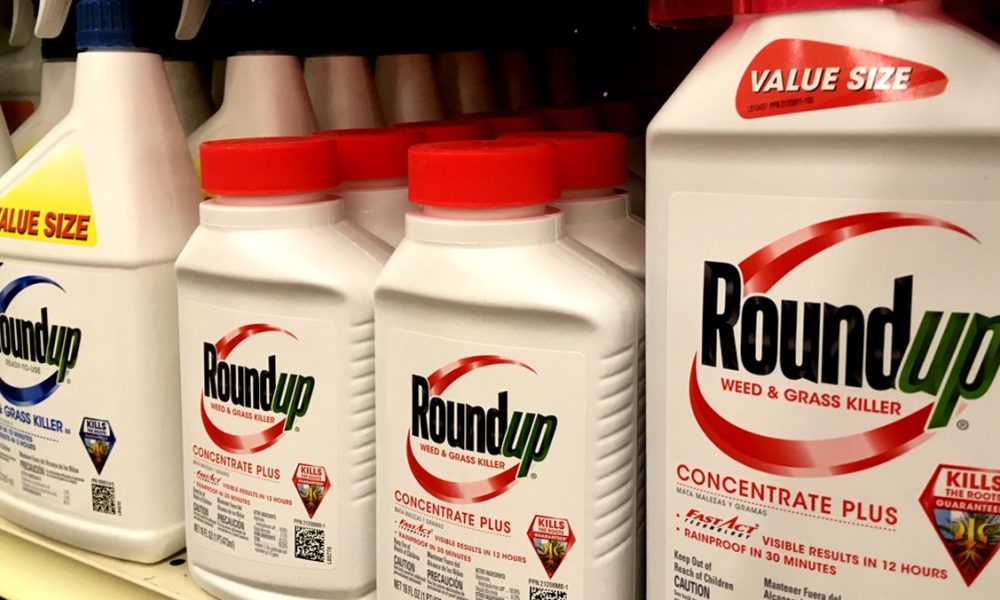 Roundup is the most widely used herbicide in Malheur County and the world, according to state and local officials. However, its future and safety is at stake following a recent California court decision. (The Enterprise/Max Egener)
Roundup is the most widely used herbicide in Malheur County and the world, according to state and local officials. However, its future and safety is at stake following a recent California court decision. (The Enterprise/Max Egener)
ONTARIO — People have relied on the herbicide Roundup to get rid of pesky weeds for decades. It’s the most widely used herbicide in Malheur County and the world, according to state and local officials.
People can buy Roundup products in any garden supply store. Farmers spray the herbicide on fields to reduce plant competition on their crops. Homeowners, public workers, and school grounds keepers use it to clear gardens and parks of weeds.
But the future and safety of the main active ingredient in Roundup products, glyphosate, is uncertain after a recent court decision in California.
A jury last month concluded that Monsanto, the producer of Roundup, was liable for causing non-Hodgkin’s lymphoma in a Bay Area school groundskeeper.
Dewayne Johnson applied the high concentration weed-killer Roundup Pro on Benicia Unified School District grounds for years. One of Johnson’s doctors testified that he is unlikely to survive to 2020. The jury awarded Johnson $289 million.
Monsanto maintains that Roundup is safe and plans to appeal the jury’s decision. There are currently 8,000 glyphosate-related lawsuits against Monsanto in the U.S., according to reporting by Reuters.
The case itself has no immediate impact on the availability of Roundup products.
But the ruling raises questions about whether the herbicide could be restricted in the future.
Municipalities in 18 U.S. states have restrictions or bans on glyphosate. Additionally, federal and local authorities in several European and South American countries have restrictions or bans.
Any changes in the availability of Roundup would stress an already fragile farm economy in Malheur County, said Stuart Reitz, the director of the Oregon State University Malheur Experiment Station.
“If you go by a field and there’s a guy with a sprayer, there’s a 99.9 percent chance he’s using Roundup,” Reitz said.
“If glyphosate went away, it would be a nuisance for homeowners, but for farmers it would be a true hardship because they don’t really have good alternatives.”
Farmers can’t afford the cost of labor to remove weeds by hand, according to Reitz.
“Overall the farm economy is not too robust these days,” he said.
There are many other weed-killers that farmers can use, but few are as effective as herbicides that contain glyphosate.
Reitz said farmers thought they had the silver bullet for weed control when Monsanto brought the chemical to market in 1974.
In the late 1990s when Monsanto developed Roundup Ready vegetables — crops genetically engineered to be unaffected by glyphosate — the use of glyphosate rapidly increased. It has increased every year since.
With crops designed to resist Roundup, some vegetables that were gradually getting less profitable became economically viable, according to Reitz.
“When Roundup Ready sugar beets were introduced, that changed the game,” Reitz said. “It actually made it practical to keep growing sugar beets because they just couldn’t get the weeds under control with the other herbicides and hand labor.”
Sugar beets are one of the most widely grown crops in Malheur County.
But the heavy use of Roundup has led to the emergence of Roundup-resistant weeds.
Individual plants possess different genetic susceptibilities to the herbicide. If one plant has a particularly high tolerance to Roundup and lives through its application, the plant’s offspring will also possess that tolerance too. Over time weeds can become highly resistant to Roundup.
“It’s essentially natural selection at work except we’re the ones facilitating the selection,” Reitz said.
Glyphosate also became prevalent because researchers thought its impacts on the environment and humans were relatively benign.
“It became so widely used because there were very few other chemicals that broke down quickly and didn’t leave residuals where it was applied,” said Rose Kachadoorian, a pesticides program manager with the Oregon Department of Agriculture.
Kachadoorian said studies initially showed that glyphosate was one of the safest herbicides on the market.
Bob Bennett is the facilities manager for the Ontario School District. He said in the 29 years he has worked for the district, he has never had any concerns about the safety of glyphosate.
“As long as you’re using it for what it’s intended for and follow the label, there’s no problem with it,” Bennett said.
He said his department doesn’t have the time or resources to weed everything by hand.
Oregon law mandates all school districts keep records of herbicide application on school grounds and develop protocols for managing weeds and other pests.
Oregon State University’s School Integrated Pest Management Program helps districts develop programs and comply with state law.
There are 16 herbicide products containing glyphosate on the OSU “low-impact pesticides” list. Four are Roundup products.
Bennett and three other licensed herbicide applicators with the district apply Roundup Pro to weeds emerging from cracks in sidewalks and on parking lots on school grounds. They apply it “once or twice” per year in five-gallon increments during the summer months.
Johnson, the Bay Area grounds keeper, said he applied Roundup Pro in 50-gallon increments 20 to 30 times per year, according to the San Francisco Chronicle.
Since Roundup typically kills all vegetation it touches, Bennett doesn’t use it for weeds in grass fields. Signs alert people when pesticides are applied.
Maintenance employees are required to get training and become licensed as an applicator.
“It’s pretty intensive,” Bennett said. “It makes sure you know how to read the label, do weed identification, and won’t apply too much.”
He said applicators always take the necessary application precautions including wearing closed-toe shoes, long sleeves and pants, gloves, goggles and face masks.
But not all Roundup users take the kinds of precautions Bennett and his coworkers do.
“You walk around your neighborhood and you see people with the backpack applicator wearing shorts and sandals, and it’s like, maybe you should do something to protect yourself a little more,” said Reitz of the experiment station.
The science around glyphosate has been in dispute.
In 2017, the federal Environmental Protection Agency concluded in a risk assessment that “glyphosate is not likely to be carcinogenic to humans.” The EPA assessed health risks of consuming residues of the chemical on food or exposure in residential and occupational settings. The agency cites similar findings by the National Institutes of Health to support its conclusion.
Other studies conflict with the EPA findings.
In 2015, the World Health Organization’s International Agency for Research on Cancer published a year-long investigation into the link between glyphosate and cancer. It stated that the chemical is a “probable human carcinogen.”
Researchers found evidence that the chemical can cause tumors in rats and mice in high doses. The study also showed that glyphosate can damage DNA in human cells.
The WHO concluded in 2016, however, that “glyphosate is unlikely to pose a carcinogenic risk to humans from exposure through the diet.”
The science has also been wrought with controversy.
Monsanto has been criticized for commissioning scientific studies to discredit the WHO findings of 2015.
A review in 2016 that was critical of the finding was later found to have been edited by a Monsanto scientist, according to emails made public in a court case against Monsanto.
“Any allegation of ghostwriting is false,” said Charla Lord, spokesperson for Monsanto, in an email last week to the Enterprise.




